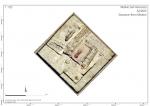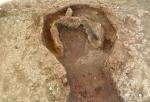Summary (English)
The site ‘Molino San Vincenzo’ is part of a network of roman villas and situated in an agriculturally
used landscape within the middle Arno- and the Pesa-valley.
In 2015, the excavation campaign was conducted from August 3rd until August 22th and continued last
year’s work with a staff of 19 people in total, including 11 students from the University of Vienna. To
do so, trench 2 of 2014 was significantly enlarged to south and west to a dimension of 193,16 sqm.
The discovery of the continuation of a foundation wall made from sandstone (which has been
discovered in 2012 already) in east-west direction was of high importance. Additionally, this foundation
wall was disturbed by another more recent concentration of stones of varying sizes.
Further it was possible to identify a round shaped furnace, which is characterized by reddish earth and
layers of charcoal in the praefurnium as well as in the lower part of the mid-sized combustion chamber.
This chamber was filled with a large amount of opus doliare and numerous fragments of pottery dating
back to the Roman age as well.
The ancient pottery found during the campaign suggests a datation from the late republican age to the
fifth century AD and gives an idea of the lively exchange of goods with the Mediterranean region.
A cumulation of metallurgical furnaces characterized by round shaped reddish layers as well as slagfragments
and a drainage consisting out of multiple rows of river pebbles, refilled with fragments of
roman tiles and large pieces of cocciopesto, can both be dated by glazed pottery to the modern era and
show the very complex history of the post-Roman site ‘Molino San Vincenzo’.
- Günther Schörner - Institut für Klassische Archäologie, Universität Wien, Austria
- Dominik Hagmann, B.A. - Institut für Klassische Archäologie, Universität Wien, Austria
Director
Team
- Günther Schörner-Institut für Klassische Archäologie, Universität Wien, Austria
- Veronika Schreck, M.A. - Institut für Klassische Archäologie, Universität Wien, Austria
Research Body
- Institut für Klassische Archäologie, Historisch-Kulturwissenschaftliche Fakultät, Universität Wien
Funding Body
- Universität Wien, FWF






![Download [PDF]](/excavation/skins/fasti/images/results/download_sml.png)
